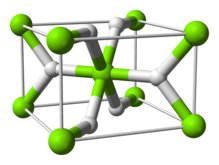
| |

| |
| Names | |
|---|---|
| IUPAC name
Magnesium hydride
| |
| Identifiers | |
3D model (JSmol)
|
|
| ChEBI | |
| ChemSpider | |
| ECHA InfoCard | 100.028.824 |
| EC Number |
|
PubChem CID
|
|
| UNII | |
| |
| |
| Properties | |
| MgH2 | |
| Molar mass | 26.3209 g/mol |
| Appearance | white crystals |
| Density | 1.45 g/cm3 |
| Melting point | 327 °C (621 °F; 600 K) decomposes |
| decomposes | |
| Solubility | insoluble in ether |
| Structure | |
| tetragonal | |
| Thermochemistry | |
Heat capacity (C)
|
35.4 J/mol K |
Std molar
entropy (S⦵298) |
31.1 J/mol K |
Std enthalpy of
formation (ΔfH⦵298) |
-75.2 kJ/mol |
Gibbs free energy (ΔfG⦵)
|
-35.9 kJ/mol |
| Hazards | |
| Occupational safety and health (OHS/OSH): | |
Main hazards
|
pyrophoric[1] |
| Related compounds | |
Other cations
|
Beryllium hydride Calcium hydride Strontium hydride Barium hydride |
| Magnesium monohydride Mg4H6 | |
Except where otherwise noted, data are given for materials in their standard state (at 25 °C [77 °F], 100 kPa).
| |
Magnesium hydride is the chemical compound with the molecular formula MgH2. It contains 7.66% by weight of hydrogen and has been studied as a potential hydrogen storage medium.[2]
- ^ Michalczyk, Michael J (1992). "Synthesis of magnesium hydride by the reaction of phenylsilane and dibutylmagnesium". Organometallics. 11 (6): 2307–2309. doi:10.1021/om00042a055.
- ^ Bogdanovic, Borislav (1985). "Catalytic Synthesis of Organolithium and Organomagnesium Compounds and of Lithium and Magnesium Hydrides - Applications in Organic Synthesis and Hydrogen Storage". Angewandte Chemie International Edition in English. 24 (4): 262–273. doi:10.1002/anie.198502621.